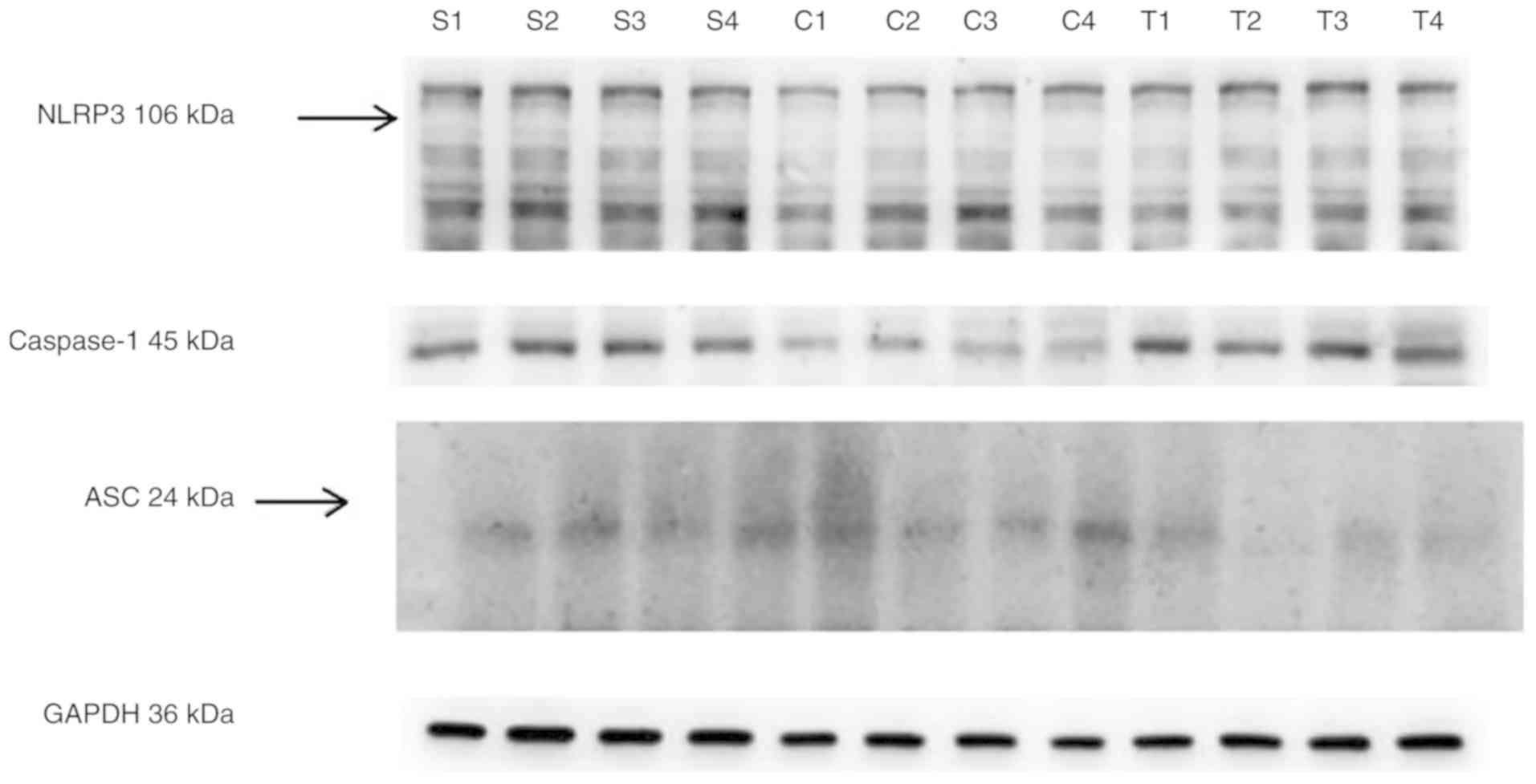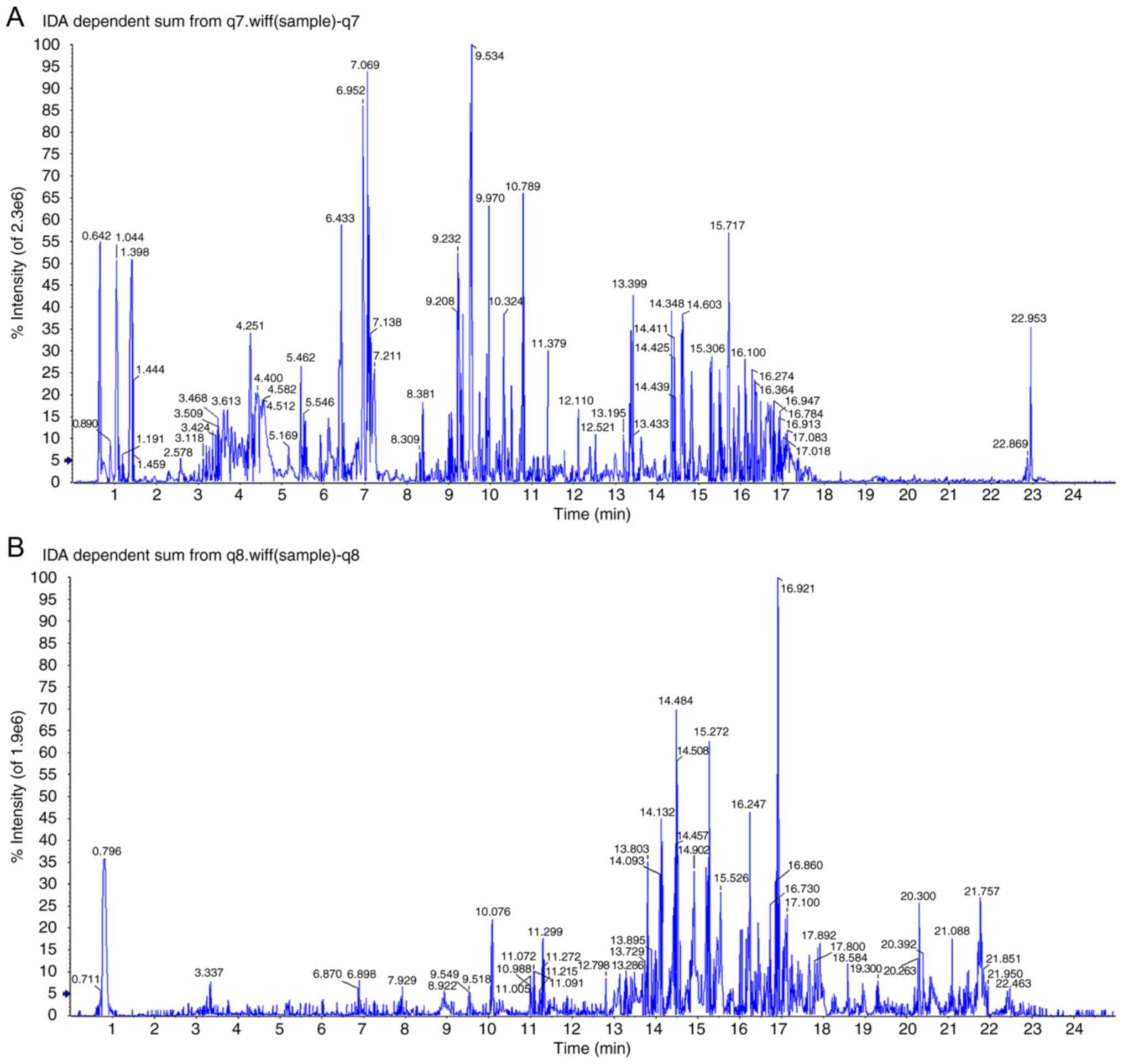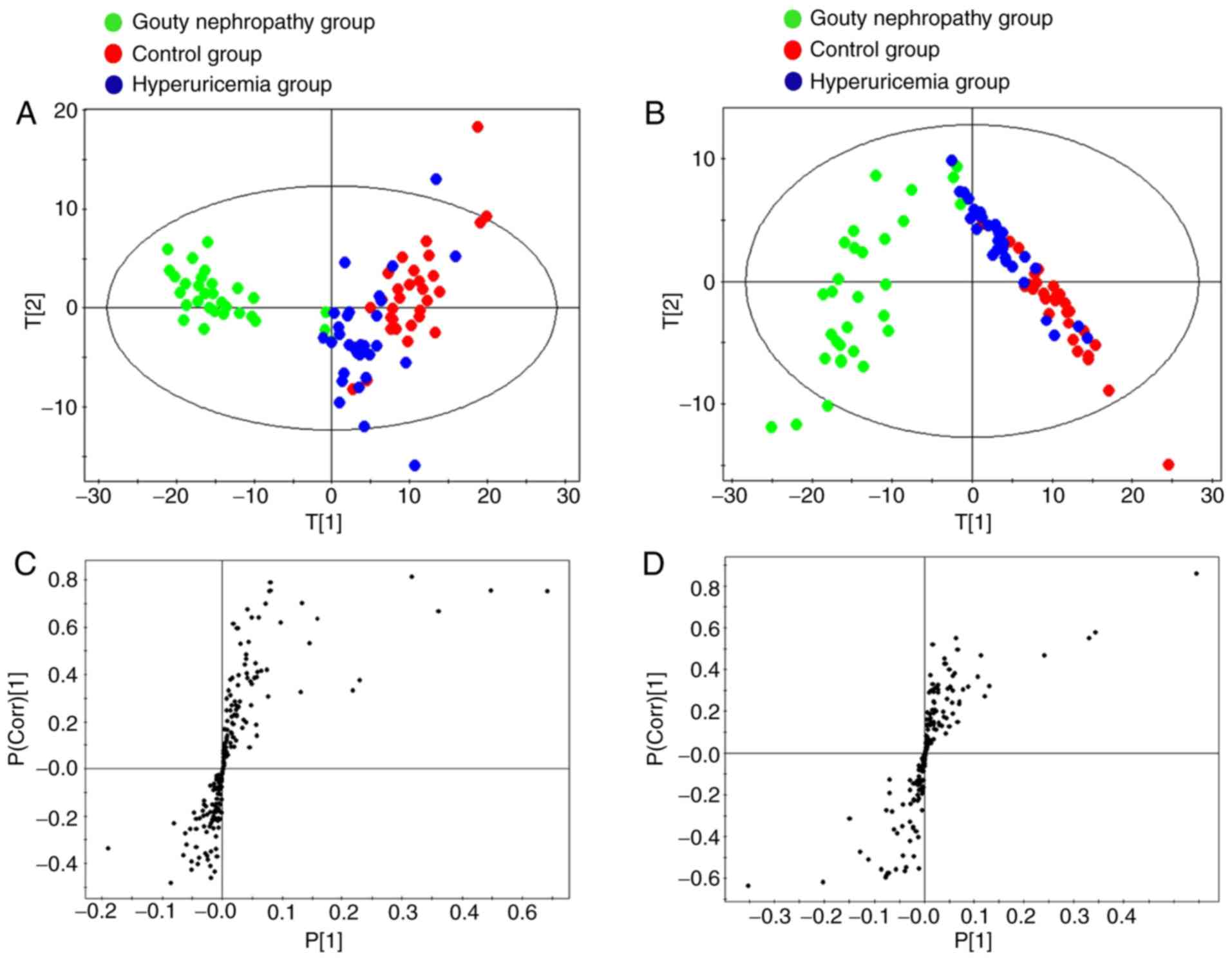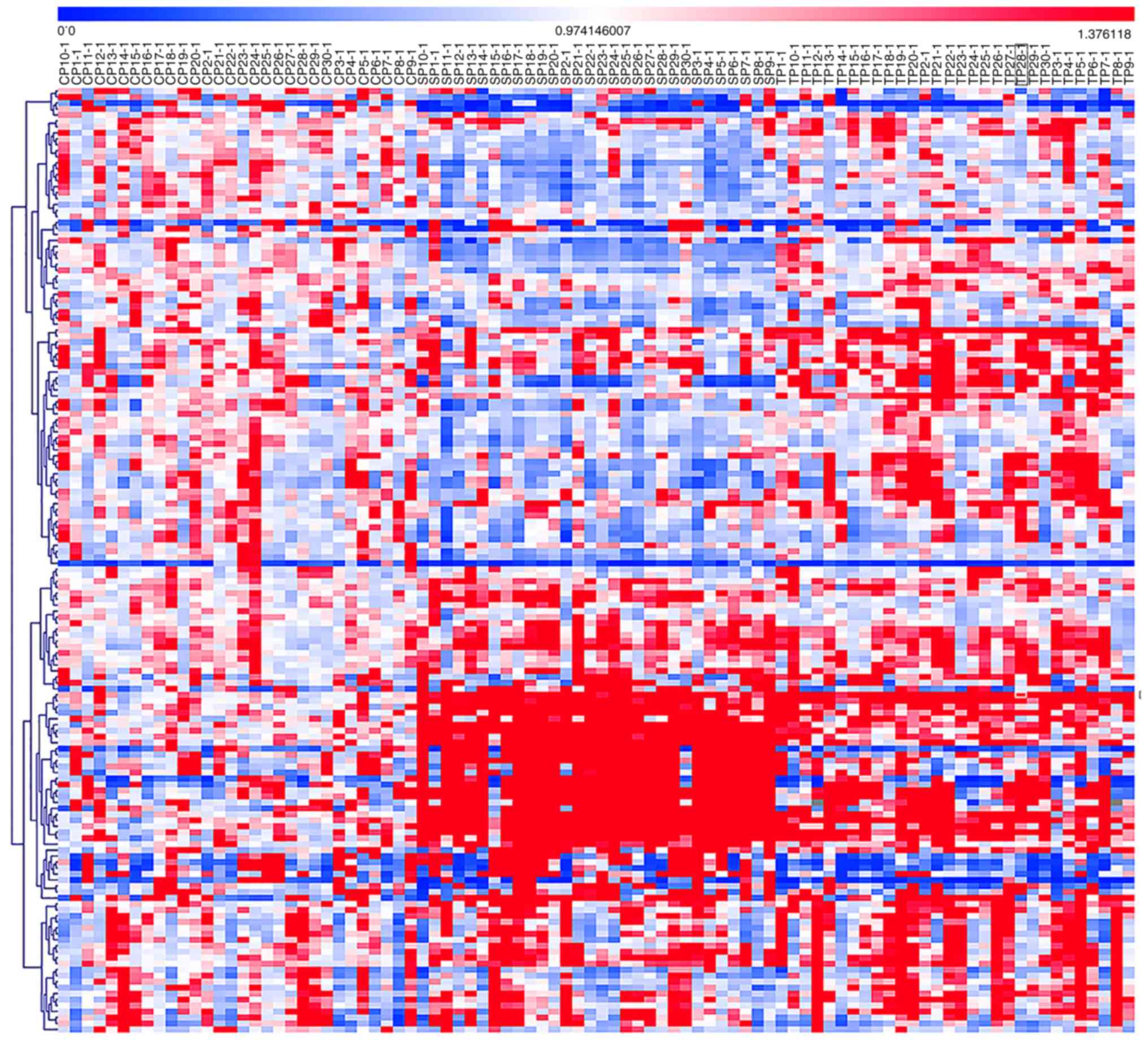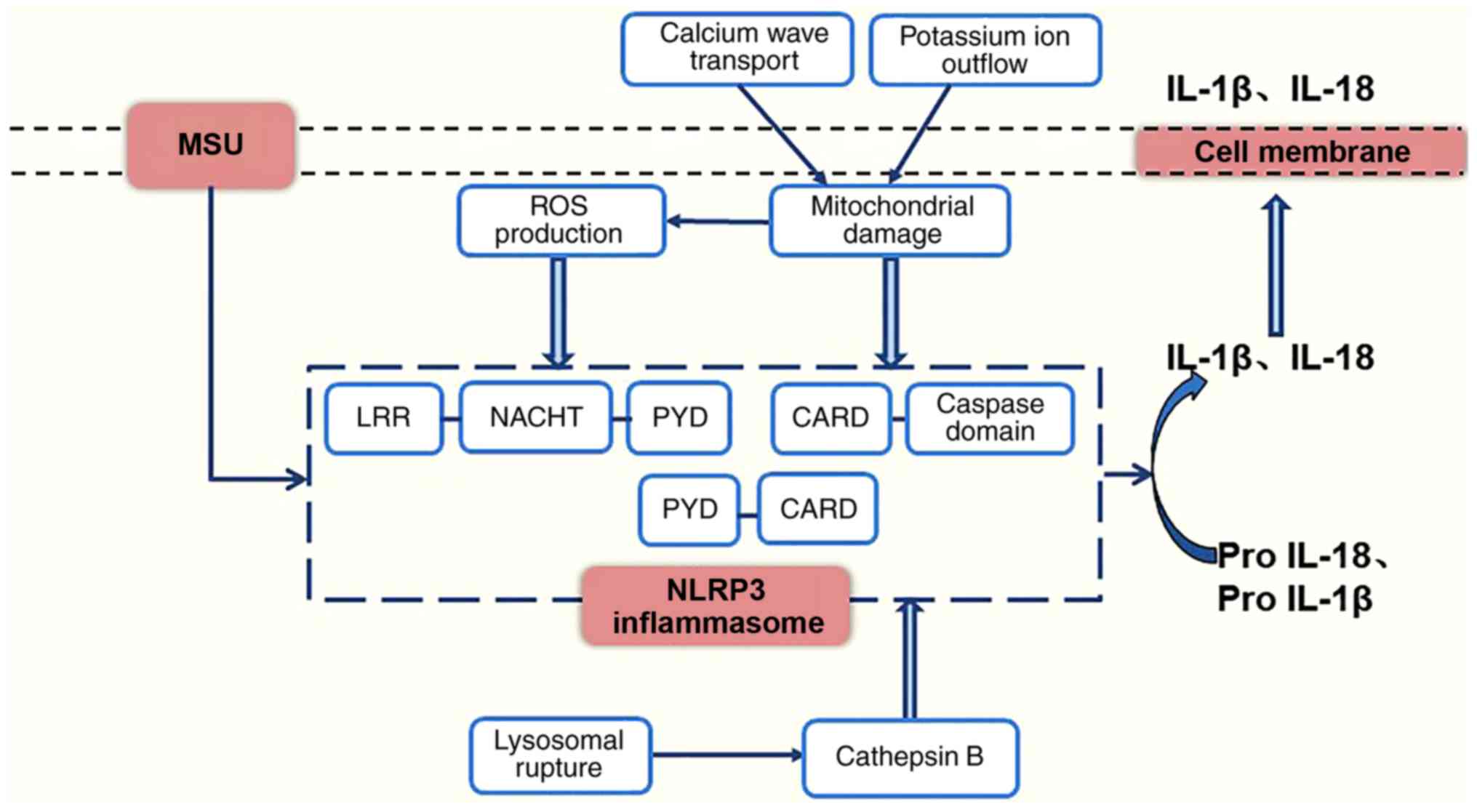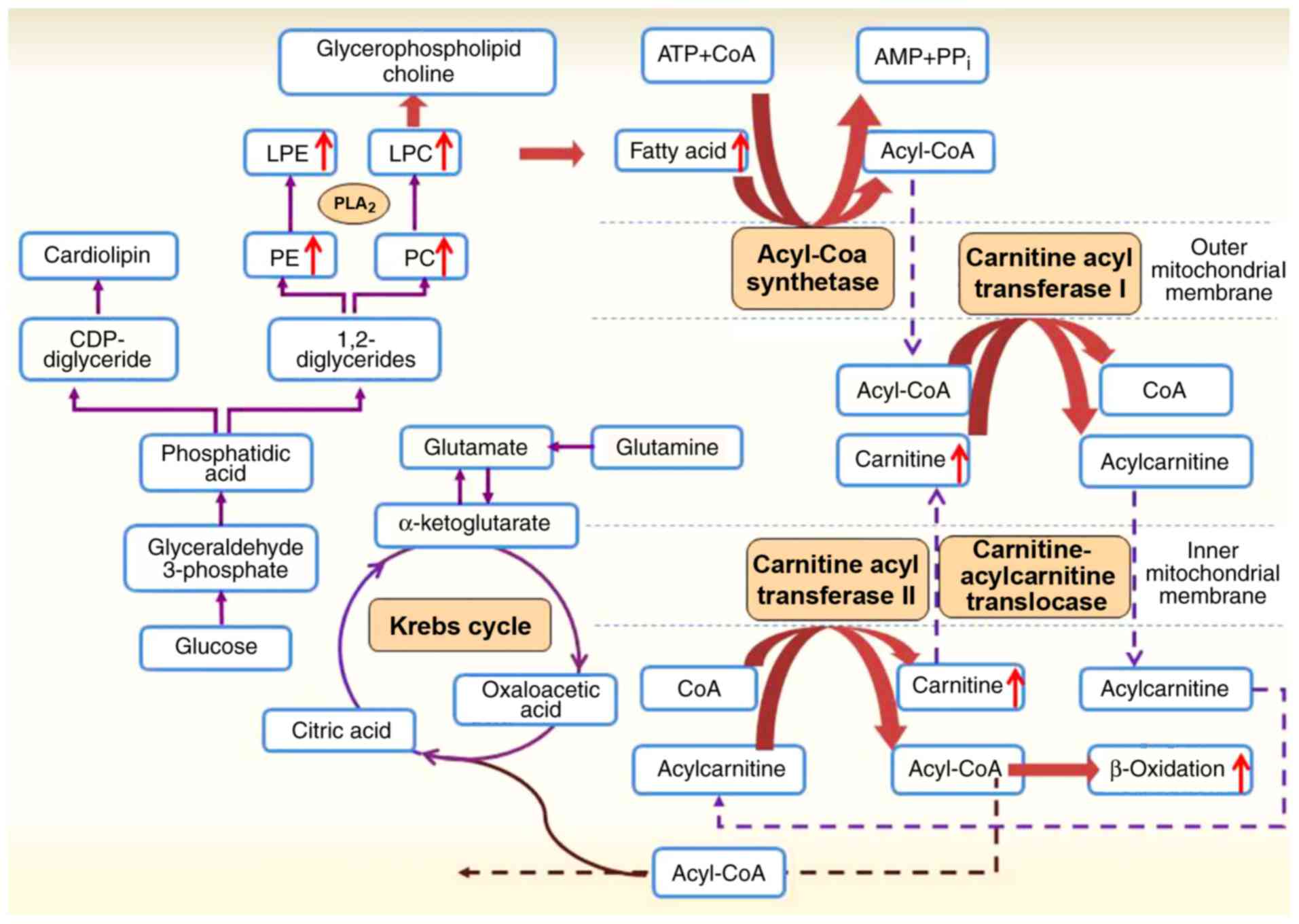|
1
|
Saito I, Saruta T, Kondo K, Nakamura R,
Oguro T, Yamagami K, Ozawa Y and Kato E: Serum Uricd acidand the
renin-angiotensin system in hypertention. J Am Geriatr Soc.
26:241–247. 1978. View Article : Google Scholar : PubMed/NCBI
|
|
2
|
Ghaemi-Oskouie F and Shi Y: The role of
Uric acid as an endogenous danger signal in immunity and
inflammation. Curr Rheumatol Rep. 13:160–166. 2011. View Article : Google Scholar : PubMed/NCBI
|
|
3
|
Yao Y, Chen S, Cao M, Fan X, Yang T, Huang
Y, Song X, Li Y, Ye L, Shen N, et al: Antigen-specific
CD8+ T cell feedback activates NLRP3 inflammasome in
antigen-presenting cells through perforin. Nat Commun. 8:154022017.
View Article : Google Scholar
|
|
4
|
Abderrazak A, Syrovets T, Couchie D, El
Hadri K, Friguet B, Simmet T and Rouis M: NLRP3 inflammasome: From
a danger signal sensor to a regulatory node of oxidative stress and
inflammatory diseases. Redox Biol. 4:296–307. 2015. View Article : Google Scholar : PubMed/NCBI
|
|
5
|
Wu R, Liu X, Yin J, Wu H, Cai X, Wang N,
Qian Y and Wang F: IL-6 receptor blockade ameliorates diabetic
nephropathy via inhibiting inflammasome in mice. Metab Clin Exp.
83:18–24. 2018. View Article : Google Scholar : PubMed/NCBI
|
|
6
|
Gonçalves JP, Oliveira A, Severo M, Santos
AC and Lopes C: Cross-sectional and longitudinal associations
between serum uric acid and metabolic syndrome. Endocrine.
41:450–457. 2012. View Article : Google Scholar : PubMed/NCBI
|
|
7
|
Borghi C, Rosei EA, Bardin T, Dawson J,
Dominiczak A, Kielstein JT, Manolis AJ, Perez-Ruiz F and Mancia G:
Serum uric acid and the risk of cardiovascular and renal disease. J
Hypertens. 33:1729–1741. 2015. View Article : Google Scholar : PubMed/NCBI
|
|
8
|
Stamp LK and Chapman PT: Gout and its
comorbidities: Implications for therapy. Rheumatology (Oxford).
52:34–44. 2013. View Article : Google Scholar
|
|
9
|
Chen JH, Yeh WT, Chuang SY, Wu YY and Pan
WH: Gender-specific risk factors for incident gout: A prospective
cohort study. Clin Rheumatol. 31:239–245. 2012. View Article : Google Scholar
|
|
10
|
Yu X, Chen K and Tong Y: Lipid metabolism
study of hyperuricemia and gout arthritis based on lipidomics
technology. World Latest Med Info. 7:30–31. 2016.
|
|
11
|
Vázquez-Mellado J, Hernández-Cuevas CB,
Alvarez-Hernández E, Ventura-Rios L, Peláez-Ballestas I,
Casasola-Vargas J, García-Méndez S and Burgos-Vargas R: The
diagnostic value of the proposal for clinical gout diagnosis (CGD).
Clin Rheumatol. 31:429–434. 2012. View Article : Google Scholar
|
|
12
|
Wallace SL, Robinson H, Masi AT, Decker
JL, McCarty DJ and Yü TF: Preliminary criteria for the
classification of the acute arthritis of primary gout. Arthritis
Rheum. 20:895–900. 1977. View Article : Google Scholar : PubMed/NCBI
|
|
13
|
Livak KJ and Schmittgen TD: Analysis of
relative gene expression data using real-time quantitative PCR and
the 2(-Delta Delta C(T)) method. Methods. 25:402–408. 2001.
View Article : Google Scholar
|
|
14
|
Zhao X, Zeng Z, Chen A, Lu X, Zhao C, Hu
C, Zhou L, Liu X, Wang X, Hou X, et al: Comprehensive strategy to
construct in-house database for accurate and batch identification
of small molecular metabolites. Anal Chem. 90:7635–7643. 2018.
View Article : Google Scholar : PubMed/NCBI
|
|
15
|
Liu T, Li S, Tian X, Li Z, Cui Y, Han F,
Zhao Y and Yu Z: A plasma metabonomic analysis on potential
biomarker in pyrexia induced by three methods using ultra high
performance liquid chromatography coupled with Fourier transform
ion cyclotron resonance mass spectrometry. J Chromatogr B Analyt
Technol Biomed Life Sci. 1063:214–225. 2017. View Article : Google Scholar : PubMed/NCBI
|
|
16
|
Heneka MT, Kummer MP, Stutz A, Delekate A,
Schwartz S, Vieira-Saecker A, Griep A, Axt D, Remus A, Tzeng TC, et
al: NLRP3 is activated in Alzheimer's disease and contributes to
pathology in APP/PS1 mice. Nature. 493:674–678. 2013. View Article : Google Scholar
|
|
17
|
Kim SM, Lee SH, Kim YG, Kim SY, Seo JW,
Choi YW, Kim DJ, Jeong KH, Lee TW, Ihm CG, et al:
Hyperuricemia-induced NLRP3 activation of macrophages contributes
to the progression of diabetic nephropathy. Am J Physiol Renal
Physiol. 308:F993–F1003. 2015. View Article : Google Scholar : PubMed/NCBI
|
|
18
|
Zheng F, Xing S, Gong Z and Xing Q: NLRP3
inflammasomes show high expression in aorta of patients with
atherosclerosis. Heart Lung Circ. 22:746–750. 2013. View Article : Google Scholar : PubMed/NCBI
|
|
19
|
Csak T, Ganz M, Pespisa J, Kodys K,
Dolganiuc A and Szabo G: Fatty acid and endotoxin activate
inflammasomes in mouse hepatocytes that release danger signals to
stimulate immune cells. Hepatology. 54:133–144. 2011. View Article : Google Scholar : PubMed/NCBI
|
|
20
|
Gao L, Shen F and LI YS: Effects of NLRP3
inflammasome on cerebral ischemia-reperfusion injury. J Shanghai
Jiaotong Univ Med Sci. 35:1896–1899. 2015.In Chinese.
|
|
21
|
Braga TT, Forni MF, Correa-Costa M, Ramos
RN, Barbuto JA, Branco P, Castoldi A, Hiyane MI, Davanso MR, Latz
E, et al: Soluble Uric acid activates the NLRP3 inflammasome. Sci
Rep. 7:398842017. View Article : Google Scholar : PubMed/NCBI
|
|
22
|
Zhou R, Tardivel A, Thorens B, Choi I and
Tschopp J: Thioredoxin-interacting protein links oxidative stress
to inflam-masome activation. Nat Immunol. 11:136–140. 2010.
View Article : Google Scholar
|
|
23
|
Bruchard M, Mignot G, Derangère V, Chalmin
F, Chevriaux A, Végran F, Boireau W, Simon B, Ryffel B, Connat JL,
et al: Chemotherapy-triggered cathepsin B release in
myeloid-derived suppressor cells activates the Nlrp3 inflammasome
and promotes tumor growth. Nat Med. 19:57–64. 2013. View Article : Google Scholar
|
|
24
|
Shimada K, Crother TR, Karlin J, Dagvadorj
J, Chiba N, Chen S, Ramanujan VK, Wolf AJ, Vergnes L, Ojcius DM, et
al: Oxidized mitochondrial DNA activates the NLRP3 inflammasome
during apoptosis. Immunity. 36:401–414. 2012. View Article : Google Scholar : PubMed/NCBI
|
|
25
|
Wang R, Wang Y, Mu N, Lou X, Li W, Chen Y,
Fan D and Tan H: Activation of NLRP3 inflammasomes contributes to
hyperhomocysteinemia-aggravated inflammation and atherosclerosis in
apoE-deficient mice. Lab Invest. 97:922–934. 2017. View Article : Google Scholar : PubMed/NCBI
|
|
26
|
Hornung V, Bauernfeind F, Halle A, Samstad
EO, Kono H, Rock KL, Fitzgerald KA and Latz E: Silica crystals and
aluminum salts activate the NALP3 inflammasome through phagosomal
destabilization. Nat Immunol. 9:847–856. 2008. View Article : Google Scholar : PubMed/NCBI
|
|
27
|
Lee GS, Subramanian N, Kim AI,
Aksentijevich I, Goldbach-Mansky R, Sacks DB, Germain RN, Kastner
DL and Chae JJ: The calcium-sensing receptor regulates the NLRP3
inflammasome through Ca2+ and cAMP. Nature. 492:123–127. 2012.
View Article : Google Scholar : PubMed/NCBI
|
|
28
|
Ives A, Nomura J, Martinon F, Roger T,
LeRoy D, Miner JN, Simon G, Busso N and So A: Xanthine
oxidoreductase regulates macrophage IL1β secretion upon NLRP3
inflammasome activation. Nat Commun. 6:65552015. View Article : Google Scholar
|
|
29
|
Rhee EP: Metabolomics and renal disease.
Curr Opin Nephrol Hypertens. 24:371–379. 2015.PubMed/NCBI
|
|
30
|
Zhao YY, Cheng XL, Lin RC and Wei F:
Lipidomics applications for disease biomarker discovery in mammal
models. Biomark Med. 9:153–168. 2015. View Article : Google Scholar : PubMed/NCBI
|
|
31
|
Sekula P, Goek ON, Quaye L, Barrios C,
Levey AS, Römisch-Margl W, Menni C, Yet I, Gieger C, Inker LA, et
al: A metabolome-wide association study of kidney function and
disease in the general population. J Am Soc Nephrol. 27:1175–1188.
2016. View Article : Google Scholar :
|
|
32
|
Makide K, Kitamura H, Sato Y, Okutani M
and Aoki J: Emerging lysophospholipid mediators,
lysophosphatidylserine, lysophosphatidylthreonine,
lysophosphatidylethanolamine and lysophosphatidylglycerol.
Prostaglandins Other Lipid Mediat. 89:135–139. 2009. View Article : Google Scholar : PubMed/NCBI
|
|
33
|
Zhang ZH, Vaziri ND, Wei F, Cheng XL, Bai
X and Zhao YY: An integrated lipidomics and metabolomics reveal
nephropro-tective effect and biochemical mechanism of Rheum
officinale in chronic renal failure. Sci Rep. 6:221512016.
View Article : Google Scholar
|
|
34
|
Zhao YY, Vaziri ND and Lin RC: Lipidomics:
New insight into kidney disease. Adv Clin Chem. 68:153–175. 2015.
View Article : Google Scholar : PubMed/NCBI
|
|
35
|
Chen DQ, Chen H, Chen L, Vaziri ND, Wang
M, Li XR and Zhao YY: The link between phenotype and fatty acid
metabolism in advanced chronic kidney disease. Nephrol Dial
Transplant. 32:1154–1166. 2017. View Article : Google Scholar : PubMed/NCBI
|
|
36
|
Tsoukalas D, Alegakis AK, Fragkiadaki P,
Papakonstantinou E, Tsilimidos G, Geraci F, Sarandi E, Nikitovic D,
Spandidos DA and Tsatsakis A: Application of metabolomics part II:
Focus on fatty acids and their metabolites in healthy adults. Int J
Mol Med. 43:233–242. 2019.
|
|
37
|
Pappa V, Seydel K, Gupta S, Feintuch CM,
Potchen MJ, Kampondeni S, Goldman-Yassen A, Veenstra M, Lopez L,
Kim RS, et al: Lipid metabolites of the phospholipase A2 pathway
and inflammatory cytokines are associated with brain volume in
paediatric cerebral malaria. Malar J. 14:5132015. View Article : Google Scholar : PubMed/NCBI
|
|
38
|
Zhang S, Zhuang J, Yue G, Wang Y, Liu M,
Zhang B, Du Z and Ma Q: Lipidomics to investigate the pharmacologic
mechanisms of ginkgo folium in the hyperuricemic rat model. J
Chromatogr B Analyt Technol Biomed Life Sci. 1060:407–415. 2017.
View Article : Google Scholar : PubMed/NCBI
|
|
39
|
Yadav D, Lee ES, Kim HM, Lee EY, Choi E
and Chung CH: Hyperuricemia as a potential determinant of metabolic
syndrome. J Lifestyle Med. 3:98–106. 2013.PubMed/NCBI
|
|
40
|
Pazos Pérez F: Uric acid renal lithiasis:
New concepts. Contrib Nephrol. 192:116–124. 2018. View Article : Google Scholar : PubMed/NCBI
|
|
41
|
Iyer SS, He Q, Janczy JR, Elliott EI,
Zhong Z, Olivier AK, Sadler JJ, Knepper-Adrian V, Han R, Qiao L, et
al: Mitochondrial cardiolipin is required for Nlrp3 inflammasome
activation. Immunity. 39:311–323. 2013. View Article : Google Scholar : PubMed/NCBI
|
|
42
|
Jiang Y, Wang M, Huang K, Zhang Z, Shao N,
Zhang Y, Wang W and Wang S: Oxidized low-density lipoprotein
induces secretion of interleukin-1β by macrophages via reactive
oxygen species-dependent NLRP3 inflammasome activation. Biochem
Biophys Res Commun. 425:121–126. 2012. View Article : Google Scholar : PubMed/NCBI
|
|
43
|
Duewell P, Kono H, Rayner KJ, Sirois CM,
Vladimer G, Bauernfeind FG, Abela GS, Franchi L, Nuñez G, Schnurr
M, et al: NLRP3 inflamasomes are required for atherogenesis and
activated by cholesterol crystals. Nature. 464:1357–1361. 2010.
View Article : Google Scholar : PubMed/NCBI
|
|
44
|
Lin SJ, Yen HT, Chen YH, Ku HH, Lin FY and
Chen YL: Expression of interleukin-1 beta and interleukin-1
receptor antagonist in oxLDL-treated human aortic smooth muscle
cells and in the neointima of cholesterol-fed endothelia-denuded
rabbits. J Cell Biochem. 88:836–847. 2010. View Article : Google Scholar
|
|
45
|
Oury C: CD36: Linking lipids to the NLRP3
inflammasome, atherogenesis and atherothrombosis. Cell Mol Immunol.
11:8–10. 2014. View Article : Google Scholar :
|
|
46
|
Johnson RJ, Nakagawa T, Sanchez-Lozada LG,
Shafiu M, Sundaram S, Le M, Ishimoto T, Sautin YY and Lanaspa MA:
Sugar, uric acid, and the etiology of diabetes and obesity.
Diabetes. 62:3307–3315. 2013. View Article : Google Scholar : PubMed/NCBI
|
|
47
|
Lanaspa MA, Sanchez-Lozada LG, Cicerchi C,
Li N, Roncal-Jimenez CA, Ishimoto T, Le M, Garcia GE, Thomas JB,
Rivard CJ, et al: Uric acid stimulates fructokinase and accelerates
fructose metabolism in the development of fatty liver. PLoS One.
7:e4794802012. View Article : Google Scholar
|
|
48
|
Yang CS, Shin DM and Jo EK: The role of
NLR-related protein 3 inflammasome in host defense and inflammatory
diseases. Int Neurourol J. 16:2–12. 2012. View Article : Google Scholar : PubMed/NCBI
|
|
49
|
Halle A, Hornung V, Petzold GC, Stewart
CR, Monks BG, Reinheckel T, Fitzgerald KA, Latz E, Moore KJ and
Golenbock DT: The nalp3 inflammasome is involved in the innate
immune response to amyloid-beta. Nat Immunol. 9:857–865. 2008.
View Article : Google Scholar : PubMed/NCBI
|
|
50
|
Emmerson BT: Effect of oral fructose on
urate production. Ann Rheum Dis. 33:276–280. 1974. View Article : Google Scholar : PubMed/NCBI
|



